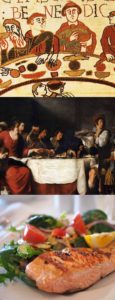Design objectives, theory and methods for landscape architecture – and for cooking
Definition of the term ‘landscape architecture’

Drawing on Oxford English Dictionary (OED) definitions:
- Design objectives are things ‘aimed at or sought; a target, goal, or end’
- Design theories are a ‘statement of rules or principles to be followed’
- Design methods are procedures ‘for attaining an object’
For a great many design activities, including landscape design and cooking, the objectives fall into the categories set out by Vitruvius
| Cooking | Landscape design |
Meals should:
Theories can be classified as:
|
Designs should have:
Theories can be classified as:
|

Daoist theories were applied to cooking and to garden design through the principle of seeking harmony between opposites. Yin and Yang are complementary. Hot and cold are complementary. Horizontal and vertical are complementary. The eternal unattainable dream is harmony. Many of these things can be seen in teachings from cooking classes near me, especially if one focuses on Asian cooking techniques.

Medieval European cooking depended on the produce of medieval gardens. Since there were few methods of preserving vegetables through the winter, there was an emphasis on peas and beans, which could be stored dry, and on kale and other tough greens which could survive hard winters. Both were cooked, long and slow, in a stew pot in the middle of a room without a chimney. Medieval landscapes and gardens were designed to provide meat, fish, fruit and vegetables.
Renaissance European cooking, for the rich, could draw on a much wider range of ingredients. Fresh meat was available in hunting parks. New techniques for storing fruits and vegetables were invented. Books on cooking and trained cooks were becoming available. High renaissance gardens and landscapes continued the tradition of design for food production but were also designed to incorporate large scale aesthetic concepts drawn from religion and science.
Modernist European cooking drew on an ever-widening sphere of nutritional knowledge, specialised techniques, and ingredients from around the world. Scientific knowledge was applied to the design of meals with good nutritional qualities and a broad concern for the health of the consumer. Modernist gardens and landscapes were also planned and design on the principle that the form should follow the function.
Kathryn Gustafson summarized her design method as ‘Words-Diagrams-Models’. It is excellent advice. But it is much closer to a ‘personal approach’ than a theory of landscape architecture. Like a personal approach to cooking (or a recipe) , it is more general than specific. I don’t know if Kathryn agrees but I would describe the theory she applies to large-scale projects as landscape urbanist.
And so to the Global Christmas Pudding at the top of this post. Every cook has her, or his, own recipe. But, if it is to be a ‘best of British’ Christmas Pud a classical design theory should guide the work:
- Functional Quality: the ingredients should be rich and rare to hearten the diner in the heart of winter
- Symbolic Quality: the pudding symbolises Christ and the empire
- Technical Quality: the pudding uses ingredients which are available when scarcely anything is growing and farm animals are being slaughtered and preserved for the frozen months ahead
These quotations are from the Wikipedia article on Christmas Pudding:
- “Many households have their own recipe for Christmas pudding, some handed down through families for generations. Essentially the recipe brings together what traditionally were expensive or luxurious ingredients – notably the sweet spices that are so important in developing its distinctive rich aroma, and usually made with suet”
- “There is a popular myth that plum pudding’s association with Christmas goes back to a custom in medieval England that the “pudding should be made on the 25th Sunday after Trinity, that it be prepared with 13 ingredients to represent Christ and the 12 apostles, and that every family member stir it in turn from east to west to honour the Magi and their journey in that direction”
- “The pudding had the great merit of not needing to be cooked in an oven, something most lower class households did not have”.
- “The ingredients used to make the pudding had to be changed to reflect the ideals of the Empire. The origins of each ingredient had to be carefully manipulated to represent each of the Empire’s many colonies. Brandy from Cyprus and nutmeg from the West Indies, which had been inadvertently forgotten in previous recipes, made special appearances”.
